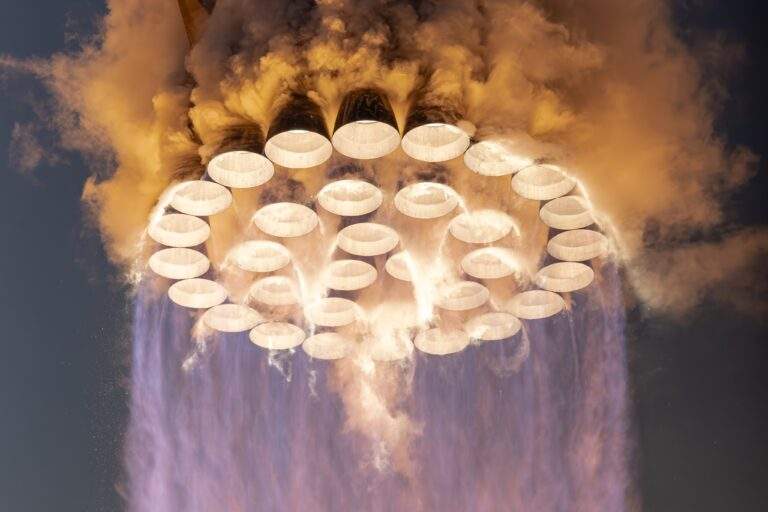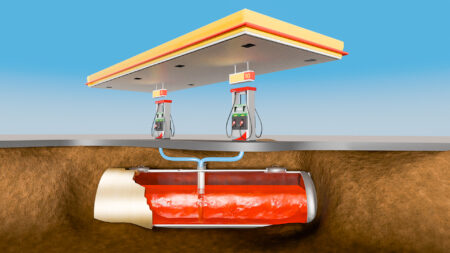Elon Musk’s SpaceX launched their 121m tall Starship for a 2nd time, completing a number of test objectives. Though first stage flight and the hot staging separation manoeuvre was a success, the company lost contact with Starship around 8 minutes after lift-off.
Starship Launch
Starship Super Heavy spectacularly lifted off from the launch pad once all 33 Raptor 2 engines had ignited, proving to be a breathtaking spectacle to those watching nearby.
In contrast to Starship’s maiden flight test, no Raptors shut down during first stage flight and so this was a key milestone for Raptor reliability.

Booster 9 and Ship 25 also successfully passed stage separation under the recently introduced hot staging separation system.
Soon after stage separation, Booster 9 experienced a rapid unscheduled disassembly (RUD). The cause of this RUD is unknown.
The Ship’s 6 Raptor engines continued to fire until reaching an altitude of around 150km where SpaceX lost contact with the vehicle.
Though both the Booster and Ship experienced an anomaly, the test flight is largely considered as a success after meeting key objectives such as a nominal stage separation.
Integrated Flight Test 1
Once huge crowds had descended to South Texas, Starship lifted off for its maiden voyage on April 20. At lift-off, chunks of concrete were seen flying from the pad during the live webcast and soon a crater was formed due to the sheer power of the booster’s 33 Raptor engines.

The vehicle continued through first stage flight, losing engines along the way, and so improving Raptor reliability is a key goal ahead of today’s test flight. As fires formed from leaking propellant in the booster, the autonomous flight safety system (AFSS) had to issue a destruct command.
Though the AFSS did destroy the vehicle, the system was delayed so SpaceX have worked on upgraded flight termination system since.
Despite a number of issues during flight 1, SpaceX learnt several lessons which have since been corrected prior to today’s launch.
Integrated Flight Test 2 Upgrades
Following Starship’s historic first test flight, SpaceX have implemented numerous upgrades to the pad, booster, and ship to increase chances of success as well as to ensure safety standards are met. This paved the way for a launch license from the Federal Aviation Administration (FAA) which was received on November 15.
Pad Upgrades
After the first flight test left a path of destruction at the orbital launch site, significant pad upgrades were required to prevent the same damage occurring again.
To mitigate against the chaos at the launch site seen during Starship’s first flight, SpaceX quickly developed a flame deflection system by installing a water-cooled steel plate underneath the orbital launch mount. This releases vast sums of water to reduce damage to the pad and the rocket. As a result, the vehicle is more likely to achieve orbit and the turnaround time between flights should improve due to less repair work being needed.

In addition, there have been foundation reinforcements at the pad due to the sizeable crater that formed from Starship lifting off in April.
Vehicle Upgrades
The introduction of a hot staging separation is perhaps the most noticeable of all vehicle changes. SpaceX have constructed an additional hot staging ring to the Starship full stack in order to assist this system.
Hot staging is the process of igniting Starship’s six second stage engines before stage separation. The engines then help push the booster away from the ship thus increasing the acceleration of Starship so increasing the vehicle’s performance.
The interstage ring contains vents to allow gases to be released and is also heavily reinforced to ensure the vehicle withstands the pressure from Starship engine ignition.

Another important vehicle upgrade is the introduction of an electronic thrust vector control (TVC) system for Super heavy’s Raptor engines. Firstly, this means there is no need for hydraulic power units (HPUs) on the booster as the engines are no longer operating under a hydraulic system, reducing the vehicle’s mass.
Now the hydraulic system is no longer used, there is a reduced chance of failure whilst the vehicle also becomes more energy efficient. As a result, the vehicle’s performance and reliability will likely improve with the addition of an electronic TVC system.
Booster 9 & Ship 25
Both Booster 9 and Ship 25 have undergone nearly flawless test campaigns prior to their test flight, performing various cryogenic proof and static fire tests.
Once Booster 9 had completed cryogenic proof testing, the vehicle underwent two static fire tests to verify that the vehicle was ready for flight.
A cryogenic proof test is where the vehicle is filled with super cold liquid nitrogen to verify the structural integrity of the vehicle. Booster 9 passed this test with aplomb.
Though mostly successful, Booster 9’s static fire tests have left some cause for concern in regard to Raptor reliability.
In early August, the booster completed a 29-engine static fire before attempting a full 33-engine static fire test later that month. During this test, all engines ignited though some shut down prematurely.
Super Heavy Booster 9 static fire successfully lit all 33 Raptor engines, with all but two running for the full duration. Congratulations to the SpaceX team on this exciting milestone! pic.twitter.com/1hzs768vHg
— SpaceX (@SpaceX) August 25, 2023
Whilst Booster 9 encountered a small issue, Ship 25 completed its campaign without any noticeable problems. The ship completed a smooth static fire test in late June proving the vehicle was ready to be stacked on top of Booster 9.
Once both the booster and ship had completed its respective testing campaigns, SpaceX placed Ship 25 on top of Booster 9 to complete the full stack.
In order to prove Starship was ready for its second flight test, the Booster 9, Ship 25 stack completed a full wet dress rehearsal in late October. A full wet dress rehearsal consists of fuelling the vehicle with liquid oxygen (LOX) and methane (CH4) and continuing the countdown to shortly before ignition.

Countdown
The final countdown for launch is expected to begin at T-2 hours where the SpaceX flight director will give a GO for propellant loading.
If a GO is given, propellant loading should soon follow at T-1 hour and 37 minutes. This is the moment where propellant begins to flow into the vehicle ahead of flight.
Once loading is nearly complete, engine chill will occur at T-19 minutes and 40 seconds. This is done in order to cool down the engines to condition them for launch.
The final landmark before launch will be activation of the flame deflection system 10 seconds prior to launch.

Soon after, all 33 Raptor engines will ignite as Starship Super Heavy will take to the sky for its second test flight.
Flight Timeline
Once Booster 9’s 33 Raptor 2 engines have ignited at lift-off, SpaceX will hope the reliability of its Raptor engine has improved since flight test 1.
Providing no significant issues, the vehicle should smoothly pass through Max-Q at T+52 seconds. Max-Q is the point at which maximum stress is placed on the vehicle during flight and so is an important test of the vehicle’s structural integrity.

If Starship makes it past maximum aerodynamic pressure, most engines cut off (MECO) will then occur at T+2 minutes and 39 seconds. This is where the hot staging manoeuvre will take place and will be an important indicator to whether the flight is considered as a success.
In the unlikely event the flight is a 100% success, the booster will land at T+6 minutes and 48 seconds whilst the ship will perform a soft landing at T+1 hour and 30 minutes.
How to Watch
SpaceX will provide a livestream of Starship’s second test flight on their website as well as X.
Third party sites such as NASASpaceflight and EverydayAstronaut will also be streaming the launch on Youtube.
(Featured Image: SpaceX)












